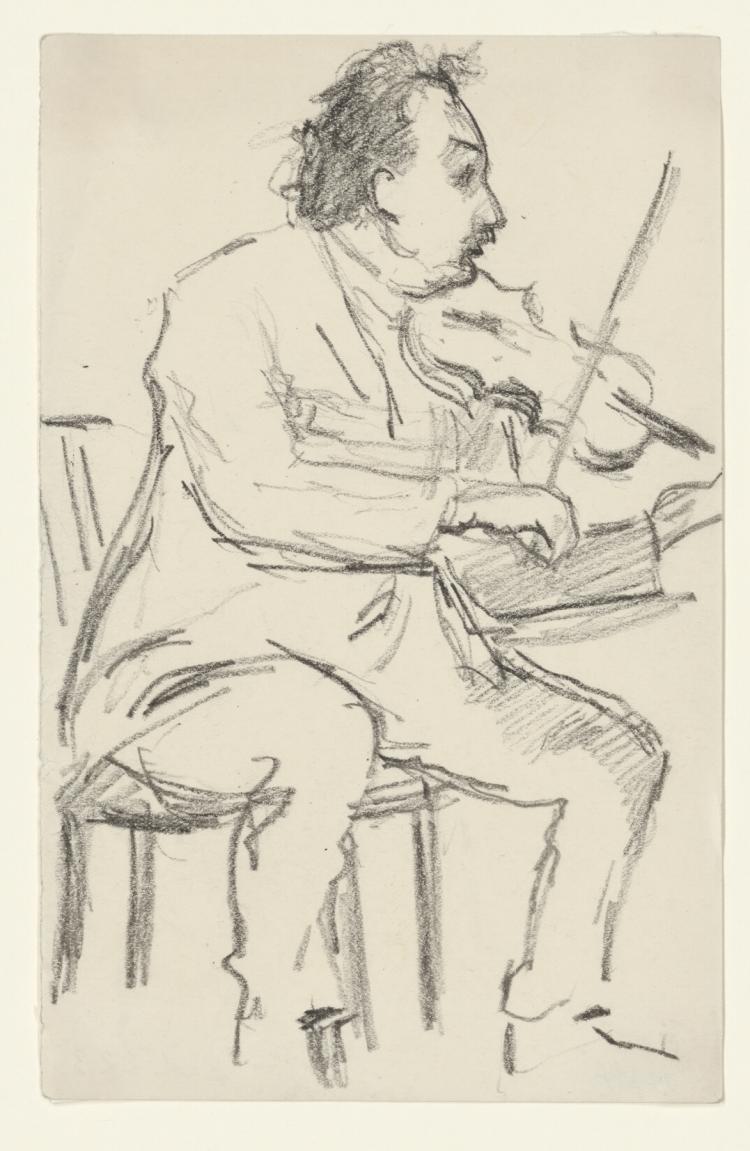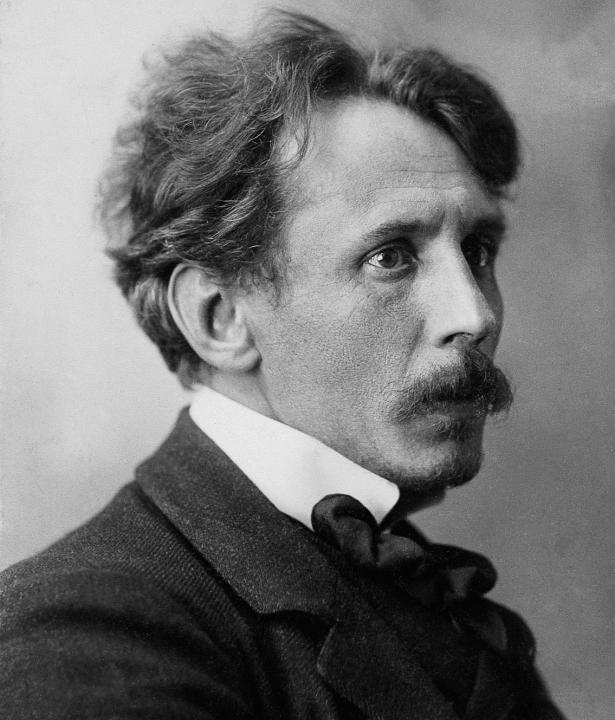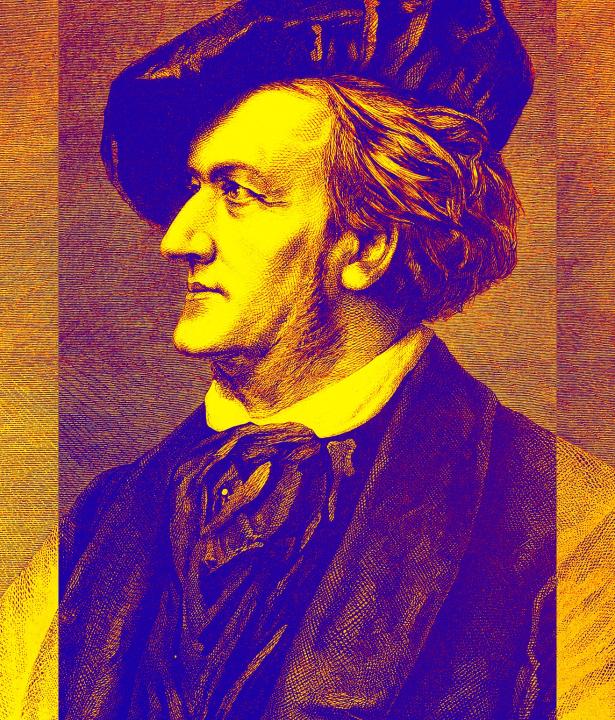Emil Orlik (1870–1932) was one of the most famous and versatile Czech artists of the turn of the century. He was known primarily as a graphic artist and draftsman whose artistic work ranged between realism and art nouveau. His extensive oeuvre includes drawings of famous contemporary musicians and composers – whom Orlik also liked to show practicing their art.
Text
Emil Orlik (1870–1932) began his art studies in Munich in the early 1890s. Initially, his hometown of remained the focus of his life and his work. Later, he often worked in Vienna, where he participated in the exhibitions of the “Secession” artists’ association. In 1905, he accepted an appointment to the state teaching institute of the Museum of Decorative Arts in Berlin, where he became head of the specialist class for graphic art and book art.
Praha
deu. Prag, eng. Prague, lat. Praga
Prague is the capital of the Czech Republic and is inhabited by about 1.3 million people, which also makes it the most populated city in the country. It is on the river Vltava in the center of the country in the historical part of Bohemia.
During his career, Orlik was not only regarded as a specialist in color woodcut and other printmaking techniques, but also as an extraordinarily versatile artist who designed books, posters, bookplates and fabric patterns, as well as stage sets and costumes, including for the German Theater in Berlin. Orlik was particularly valued as a portraitist.
The Collection at the Kunstforum Ostdeutsche Galerie
Alongside the copperplate engraving cabinets in Berlin and Dresden, the Kunstforum Ostdeutsche Galerie (KOG) holds one of the most comprehensive collections of works by Emil Orlik. With over 2,000 objects, the Orlik holdings form one of the focal points of the museum’s graphic arts collection. Of particular note are the 1,400 drawings, mostly from Orlik’s disassembled sketchbooks. 500 prints complement the graphic arts holdings. In addition, there are eleven paintings and one intarsia work at the KOG.
Most of the collection comes from the Adalbert-Stifter-Verein in Munich. In 1964, the association succeeded in acquiring a large collection of Orlik works from the antiquarian bookshop Gilhofer in Vienna. The association also gave archive material on Emil Orlik to the KOG on permanent loan. Among them is the transcribed correspondence between the artist and Max Lehrs, the long-time director of the Kupferstichkabinett in Dresden.
The Kunstforum Ostdeutsche Galerie recently presented a selection from its rich holdings in the exhibition “Zwischen Japan und Amerika. Emil Orlik. Ein Künstler der Jahrhundertwende” (“Between Japan and America. Emil Orlik. A Turn of the Century Artist”) in 2012/2013.
Musicians, conductors, composers – portrayed by Emil Orlik
Emil Orlik’s contemporaries enjoyed being painted and drawn by the skilled draftsman and graphic artist. Orlik began his career as a portraitist in Vienna shortly after the turn of the century. Gustav Mahler and Max Klinger were among his first models here. When Orlik moved to Berlin, he again found a prominent clientele, benefiting from his contacts in artistic circles. In addition to commissioned works, his spontaneous, quick drawings are particularly fascinating.
A total of eight portraits of musicians, conductors and composers were selected for the thematic series presented here. They represent the broad spectrum of Orlik’s work. In addition to precise and intricate etchings in which he captures the facial features of the sitter in great detail, other sketches show Orlik’s gift for capturing the essence with just a few strokes. Orlik’s feeling for his subject is striking. While he concentrates on the head of the composers in accordance with their intellectual work, he often captures the musicians and conductors in full-figure studies. In this way he succeeds in conveying to the viewer an idea of the experience of music, which is expressed in the postures of the sitters.
Musicians in action
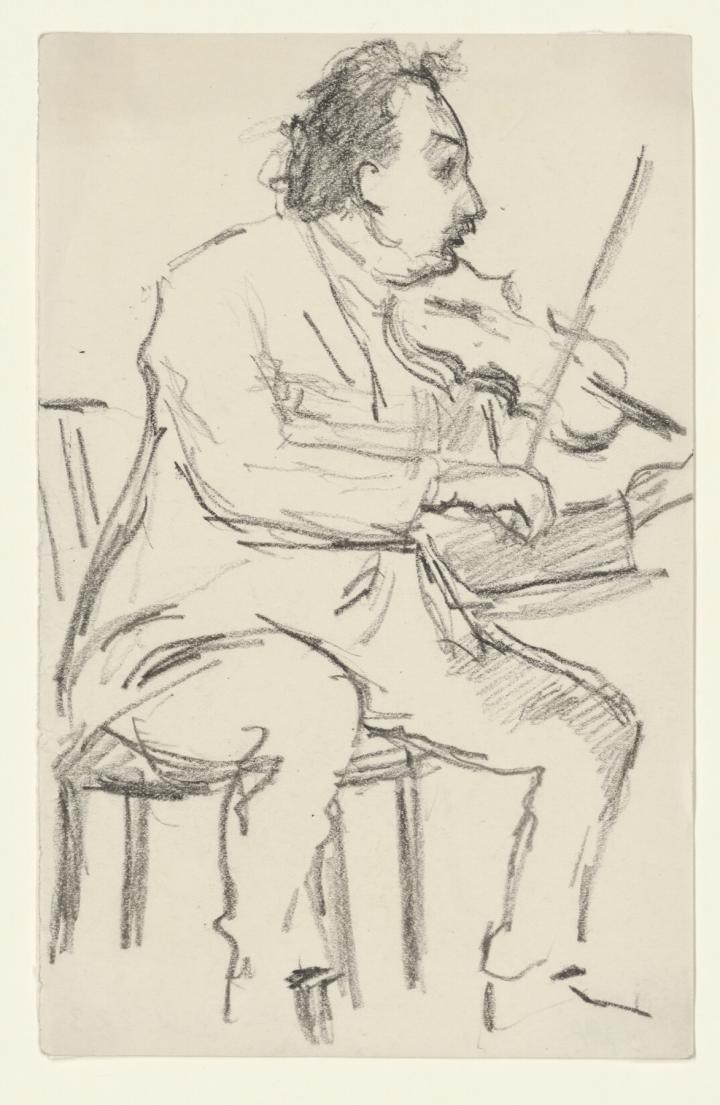

Emil Orlik: Albert Einstein beim Geigenspielen (Albert Einstein Playing the Violin), 1923/24 (From the sketchbook “Amerika 1923/24“). Black chalk, 20.0 x 12.9 cm (sheet). Kunstforum Ostdeutsche Galerie Regensburg, Inv.Nr. 15794. Free access - no reuse
Emil Orlik: Albert Einstein beim Geigenspielen (Albert Einstein Playing the Violin), 1923/24 (From the sketchbook “Amerika 1923/24“). Black chalk, 20.0 x 12.9 cm (sheet). Kunstforum Ostdeutsche Galerie Regensburg, Inv.Nr. 15794. Free access - no reuse
Text
Emil Orlik portrayed the famous physicist Albert Einstein (1879–1955) several times – the first time in 1917. The painting is in the Jewish Museum in Prague. This sketch was done in New York, where the two met during Orlik’s trip to America. It is special because it shows the scientist engrossed in playing the violin. The instrument was Einstein's faithful companion and music was an important channel through which he liked to express himself. The drawing comes from the sketchbook Orlik used in America. It later served the artist as a model for a lithograph.


Emil Orlik: Edwin Fischer, Klavier spielend (Edwin Fischer, Playing the Piano), 1920. Ink pen, 13.1 x 18.7 cm (sheet). Kunstforum Ostdeutsche Galerie Regensburg, Inv.Nr. 4392 (on loan from the Federal Republic of Germany). Free access - no reuse
Emil Orlik: Edwin Fischer, Klavier spielend (Edwin Fischer, Playing the Piano), 1920. Ink pen, 13.1 x 18.7 cm (sheet). Kunstforum Ostdeutsche Galerie Regensburg, Inv.Nr. 4392 (on loan from the Federal Republic of Germany). Free access - no reuse
Text
Edwin Fischer (1886–1960) worked as a teacher at the Music Institute for Foreigners in Potsdam from 1914, where he exerted a great influence on young pianists from all over the world by leading the “Summer Courses”. Emil Orlik captured him with only a few pen strokes, bending over the keyboard. Orlik shows nothing of his face. Averted from the viewer, the virtuoso devotes his full attention to playing the piano.


Emil Orlik: Wanda Landowska am Flügel (Wanda Landowska at the Grand Piano), 1917 (From the sketchbook “1917“). Black chalk, 19.6 x 12.6 cm (sheet). Kunstforum Ostdeutsche Galerie Regensburg, Inv.Nr. 15727. Free access - no reuse
Emil Orlik: Wanda Landowska am Flügel (Wanda Landowska at the Grand Piano), 1917 (From the sketchbook “1917“). Black chalk, 19.6 x 12.6 cm (sheet). Kunstforum Ostdeutsche Galerie Regensburg, Inv.Nr. 15727. Free access - no reuse
Text
The Polish pianist and composer Wanda Landowska (1879–1959) was considered one of the best music teachers of her time. In 1925 she founded her own school in Paris, the “École de Musique Ancienne”. Before that, she taught at the Berlin Hochschule für Musik between 1913 and 1919. It was probably here that Emil Orlik’s sketch was made. Like Edwin Fischer, Landowska is also turned towards her grand piano. In particular, the eyes are drawn to her fingers, which appear to be moving quickly. Orlik used the motif from his sketchbook as a model when producing the lithograph.
Conductors in action


Emil Orlik: Willem Mengelberg, 1925 (Sheet 10 from the portfolio “Willem Mengelberg. 10 oorsprongelyke lithographieen van Emil Orlik“). Chalk lithograph, 32.8 x 25.3 cm (sheet). Kunstforum Ostdeutsche Galerie Regensburg, Inv.Nr. 1037. Free access - no reuse
Emil Orlik: Willem Mengelberg, 1925 (Sheet 10 from the portfolio “Willem Mengelberg. 10 oorsprongelyke lithographieen van Emil Orlik“). Chalk lithograph, 32.8 x 25.3 cm (sheet). Kunstforum Ostdeutsche Galerie Regensburg, Inv.Nr. 1037. Free access - no reuse
Text
Emil Orlik dedicated an entire portfolio of ten lithographs to the Dutch conductor and composer Willem Mengelberg (1871–1951). For 50 years Mengelberg was head of the Concertgebouw Orchestra Amsterdam, which became world famous for its virtuosity under his direction. In this sheet from the portfolio, Orlik captures Mengelberg’s concentrated facial expression. He focuses on the conductor’s hands in four separate studies.


Emil Orlik: Wilhelm Furtwängler, dirigierend (Wilhelm Furtwängler, conducting), around 1925. Black chalk, 23.5 x 15.9 cm (sheet). Kunstforum Ostdeutsche Galerie Regensburg, Inv.Nr. 16043. Free access - no reuse
Emil Orlik: Wilhelm Furtwängler, dirigierend (Wilhelm Furtwängler, conducting), around 1925. Black chalk, 23.5 x 15.9 cm (sheet). Kunstforum Ostdeutsche Galerie Regensburg, Inv.Nr. 16043. Free access - no reuse
Text
Wilhelm Furtwängler (1886–1954) held several prominent positions as a conductor in the 1920s. He succeeded Richard Strauss at the Berlin State Opera from 1920, and from 1922 he was chief conductor of the Berlin Philharmonic Orchestra. In Vienna, he was one of two concert directors of the Gesellschaft der Musikfreunde until 1927, and, at the same time, conducted the Gewandhaus Orchestra in Leipzig until 1928. During one performance, Emil Orlik sketched Furtwängler on a page of the concert program. The artist was probably not satisfied with his first drawing, because he crossed it out, turned the page over and started again.
Portraits of composers


Emil Orlik: Gustav Mahler, 1902. Etching, 39.6 x 28.1 cm (sheet). Kunstforum Ostdeutsche Galerie Regensburg, Inv.Nr. 1059. Free access - no reuse
Emil Orlik: Gustav Mahler, 1902. Etching, 39.6 x 28.1 cm (sheet). Kunstforum Ostdeutsche Galerie Regensburg, Inv.Nr. 1059. Free access - no reuse
Text
The portrait of Gustav Mahler (1860–1911) is one of Orlik’s most famous. It is assumed that it was painted during Orlik’s stay in Vienna in the spring of 1902. At that time, Mahler was working as the conductor and director of the Vienna Opera House – one stop in a long and varied career. In the 1880s, he held the position of a musical director and conductor at the New German Theater in Orlik’s native Prague. Mahler himself came from the Bohemian village of . For the portrait of his compatriot, Orlik chooses an unusual point of view. He paints the face in fine detail and sculpts it elaborately with light and shadow. It almost appears photographed, in contrast to the jacket, which is simply hinted at using a single line.
Kaliště u Humpolce
deu. Kalischt, deu. Schönfeld
Kaliště u Humpolce is a municipality in the Czech Republic, located in the southeast of the historical region of Bohemia. It has 350 inhabitants and is best known for its namesake village Kaliště, the birthplace of composer Gustav Mahler (1860-1911).
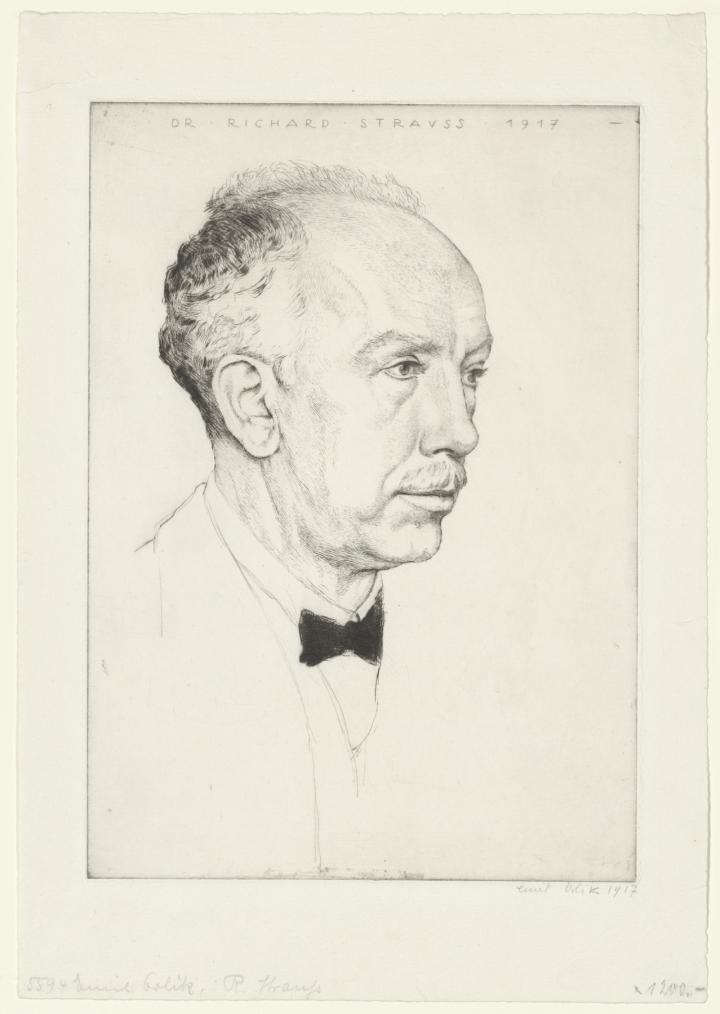

Emil Orlik: Richard Strauss, 1917. Etching, 34.0 x 24.0 cm (sheet). Kunstforum Ostdeutsche Galerie Regensburg, Inv.Nr. 134. Free access - no reuse
Emil Orlik: Richard Strauss, 1917. Etching, 34.0 x 24.0 cm (sheet). Kunstforum Ostdeutsche Galerie Regensburg, Inv.Nr. 134. Free access - no reuse
Text
Orlik portrayed Richard Strauss (1864–1949) in the penultimate year of the famous composer’s Berlin period. Strauss had worked here for twenty years as conductor at the Prussian Court before moving to the Vienna Court Opera. Emil Orlik was a friend of the Strauss family. With great precision, he brings to life the features of the early 50-year-old. In order to capture the sitters as realistically as possible, Orlik often used the so-called “glass plate apparatus”. First, he would record all the important lines on the glass plate through which he viewed his model. Then, he would transfer the drawing to paper, which he would finally use to etch the printing plate.


Emil Orlik: Richard Wagner, 1898. Etching, 7.5 x 10.0 cm (sheet). Kunstforum Ostdeutsche Galerie Regensburg, Inv.Nr. 1008. Free access - no reuse
Emil Orlik: Richard Wagner, 1898. Etching, 7.5 x 10.0 cm (sheet). Kunstforum Ostdeutsche Galerie Regensburg, Inv.Nr. 1008. Free access - no reuse
Text
The portrait of Richard Wagner (1813–1883) is one of Emil Orlik’s portraits of historical figures. A drawing of Ludwig van Beethoven, which is also in the KOG, dates from the same year. In Wagner's case, Orlik focuses on the head. He shows the esteemed innovator of European music from a slightly lower angle, so that the viewer looks up at him. While Orlik usually reproduced the facial features of his contemporaries in great detail, here he uses a reduced line drawing.
Text
English translation: William Connor

